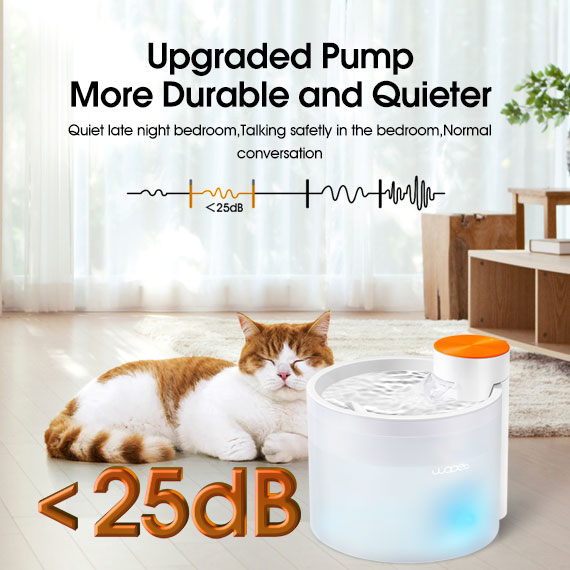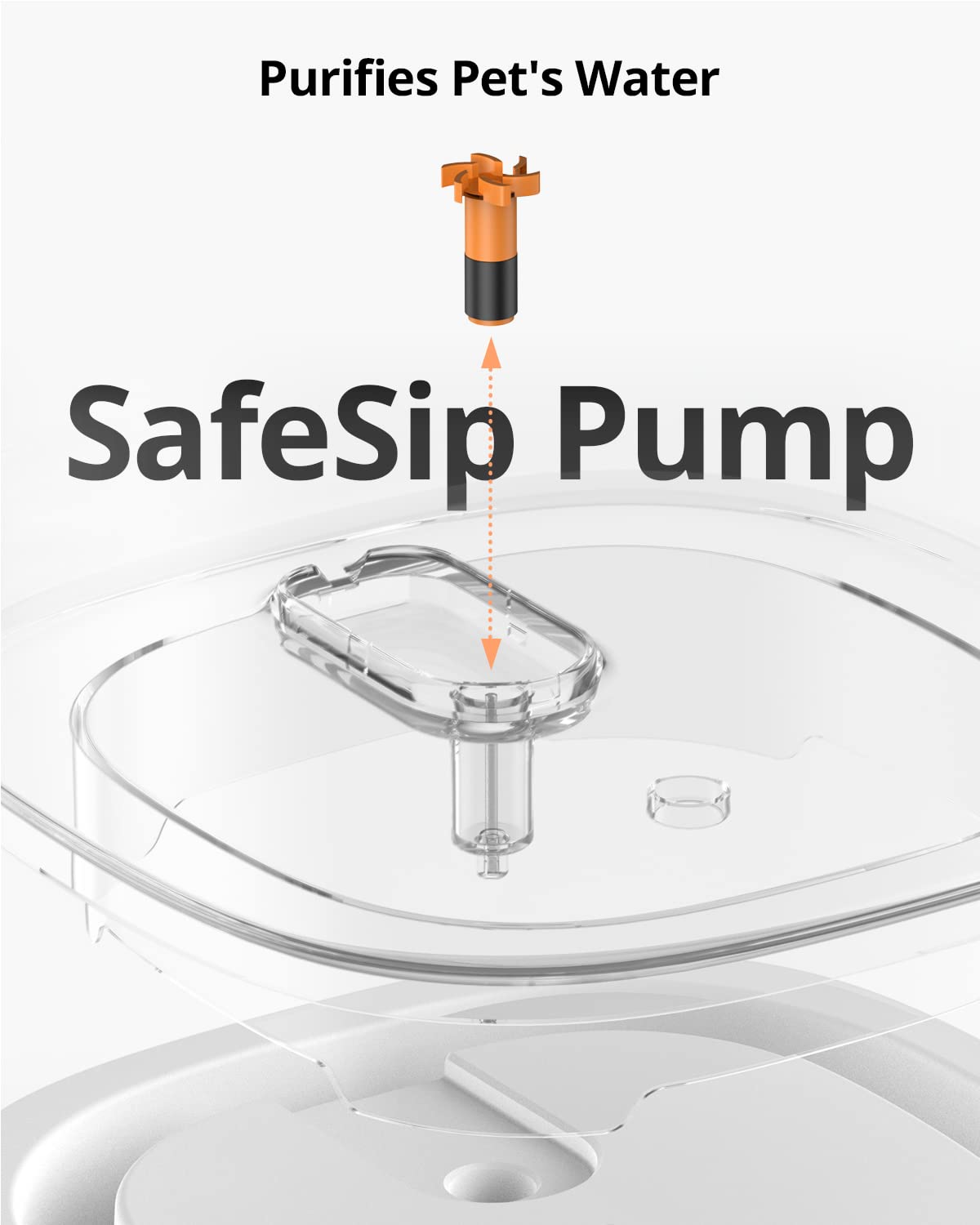To make a cat water fountain quieter, ensure it’s clean and the water level is high. Adjusting the pump speed and placing it on a soft surface can also reduce noise.
Cat owners cherish the health benefits that water fountains provide for their feline friends, but the noise can sometimes be bothersome. A fountain that hums too loudly disrupts the peaceful ambiance of home environments, potentially causing both pet and owner undue stress.
Proper maintenance and strategic placement are key to preventing annoying sounds. By addressing these simple factors, you can enjoy the purring of your cat rather than the persistent hum of their water source. Ensuring a quiet operation enhances the overall experience, fostering a serene setting that encourages your pet to stay hydrated without the unwanted background noise.

Credit: wopet.com
Silent Sips For Your Feline Friend
Imagine your cat enjoying a peaceful drink. No buzz, no hum — just pure contentment. Achieving a serene environment for your pet is key, especially for their hydration station. Discover the secrets to making a cat water fountain whisper-quiet with the following insights.
Importance Of Quiet Hydration
Cats adore tranquility. Their sensitive ears pick up every sound. Quiet water fountains can encourage them to drink more. This leads to better health and happiness.
- Improves hydration habits
- Eases stress and anxiety
- Promotes kidney function and overall well-being
Typical Noises From Cat Water Fountains
Various sounds can come from a cat fountain. These noises could deter your cat from drinking. Understanding common sounds helps in finding solutions.
| Sounds | Possible Causes |
|---|---|
| Humming | Pump operation |
| Gurgling | Low water levels |
| Splashing | Water flow adjustments |
Identify the source, and the path to silence begins. Increasing the comfort of your cat’s hydration station enhances their health and mood.
Identifying The Noise Culprits
Is your peaceful home being interrupted by a noisy cat water fountain? Don’t worry – many cat owners face this same challenge. Before you can quiet down your fountain, you need to pinpoint what’s making the noise. Let’s explore the common culprits together, so you can bring tranquility back to your space.
Motor Humming And Vibrations
The motor is the heart of your cat water fountain. But sometimes, it can turn into a source of constant hum or vibration. Here’s how to tackle this noise issue:
- Check the motor position: Ensure it’s properly seated and not touching the sides of the fountain.
- Examine the motor mount: A loose mount can lead to unnecessary vibrations. Tightening the screws might solve the problem.
- Clean the motor: Built-up debris can make the motor work harder, causing more noise. Regular cleaning is a must.
- Add padding: Placing a soft pad or mat under the fountain can reduce vibrations on hard surfaces.
Water Flow And Splashing Sounds
Water sounds can be soothing, but not when they’re too loud. Here are a few tricks to soften the water flow and splashing:
- Adjust the water level: Keep the water high enough to minimize the impact noise.
- Change the flow settings: If your fountain has adjustable flow, find the setting that works best for you and your cat.
- Check for obstacles: Sometimes, a stray toy or a bit of cat food can redirect the water flow and cause additional noise.
- Add smooth stones: Stones in the bowl can help break the fall of the water, leading to quieter splashes.
Simple Solutions For Sound Reduction
Is your cat’s water fountain too loud? Cats love fresh, flowing water. But loud noises from a water fountain might scare them. Don’t worry! You can easily make it quieter.
Here are simple ways to reduce the noise. You’ll have a serene space for your cat in no time.
Optimizing Water Levels
Right water levels can cut noise. Here’s what to do:
- Check Manufacturer Guidelines: See the recommended water level.
- Fill to the Max: Keep the water level high. It reduces splashing sounds.
- Avoid Too Low: Low water levels cause pump noise. Refill often.
Sound-proofing With Mats And Pads
Soft mats or pads under the fountain can help. They absorb sound. You’ll notice a difference. Here’s how to set them up:
- Choose Sound-Absorbing Materials: Rubber mats or foam pads work best.
- Cut to Fit: Trim the mat to match the fountain’s base.
- Place Under Fountain: Set the fountain on the mat. Now it’s quieter!

Credit: us.eufy.com
Technical Tweaks And Maintenance
Your cat’s water fountain should be a source of peace, not noise. Regular maintenance and some technical adjustments can make a world of difference. Let’s dive into some tips and tweaks to help you achieve a tranquil, almost silent water fountain for your feline friend.
Cleaning Tips To Reduce Noise
A clean fountain is a quiet fountain. Build-up of hair and debris in the pump can cause unusual noise levels. Follow these cleaning steps regularly:
- Disassemble and clean all parts every week.
- Use a soft sponge and mild dish soap.
- Rinse all components with lukewarm water.
- Clean the pump by soaking in white vinegar to break down minerals.
- Replace water filters as per manufacturer’s guidelines.
Adjustments For A Quieter Pump
The pump is the heart of the fountain and can be a source of noise if not adjusted properly.
| Adjustment | Instructions |
|---|---|
| Check the water level | Ensure the water covers the pump entirely to prevent gurgling sounds. |
| Reposition the pump | Ensure it’s firmly seated on the bottom to minimize vibrations. |
| Inspect impeller | Make sure it’s free of debris for smooth operation. |
| Use a pre-filter sponge | It’ll reduce noise and extend the life of your pump. |
| Adjust flow rate | Decrease it to minimize splashing and humming sounds. |
Regular check-ups are key to keeping your cat’s fountain running quietly. Perform these technical adjustments, and enjoy the serenity of your happy, hydrated cat.
Upgrading Your Cat’s Fountain
Welcome to the ultimate guide on upgrading your cat’s water fountain. A quiet and serene environment is beneficial for you and your feline friend. Learn how to make your cat’s water-fountain experience as peaceful as possible. Dive into finding a whisper-soft fountain and employing easy DIY tricks for a tranquil sip every time.
Selecting A Naturally Quiet Model
Finding a fountain that purrs rather than roars begins with smart selection:
- Research brands for silence claims. Look for labels like “silent” or “ultra-quiet”.
- Read user reviews carefully. Real experiences often highlight noise levels.
- Prefer fountains with adjustable flow. Control the water stream and reduce noise.
- Choose models with a large water capacity. Less refill frequency means less noise.
- Inspect the pump design. Submersible pumps generally run quieter.
Diy Enhancements For Silence
With a few home adjustments, existing fountains can also achieve hush-toned operation:
- Place a mat underneath. A rubber or foam mat can dampen vibrations.
- Ensure proper water level. Low water leads to loud pump noises.
- Clean regularly. A fountain free of debris operates more quietly.
- Use a pre-filter. This extends the pump’s life and minimizes sound.
- Check for loose parts. Secure any rattling components.
Creating A Serene Environment
Creating a serene environment for both you and your feline friend includes ensuring a peaceful setting. A quiet cat water fountain contributes to this tranquility. With simple adjustments, your home can maintain a calm ambiance, perfect for relaxation and your cat’s contentment. Let’s explore practical tips to make your cat water fountain quieter.
Strategic Placement Away From Echoes
Where you place the cat water fountain can significantly impact its noise level. Hard surfaces can amplify sounds, causing a simple fountain hum to turn into a disruptive echo:
- Choose a spot with plenty of soft surfaces nearby.
- Rugs or carpets can help mute the sounds.
- Corner spaces tend to reduce noise by containing sounds.
- Keep the fountain away from tiled areas to prevent echoes.
Combining Fountains With Other Calming Sounds
A cat water fountain doesn’t have to be the only sound in the room. Combining it with soothing background sounds can enhance the peaceful atmosphere:
- A whisper-quiet air purifier can provide gentle white noise.
- Soft instrumental music sets a relaxing mood.
- Indoor wind chimes contribute to a gentle acoustic environment.
Remember, creating a serene environment involves not only reducing noise but also harmonizing the sounds within your space. With these strategies, you can enjoy a quiet, stress-free haven alongside your feline companion.

Credit: www.amazon.com
Frequently Asked Questions On How To Make Cat Water Fountain Quieter
Why Is My Cat Water Fountain Loud?
A noisy cat water fountain is often due to low water levels or a dirty pump. Maintaining an adequate water level and regular cleaning helps minimize noise. Positioning the fountain on a flat, stable surface also reduces sounds.
How Do I Clean My Cat’s Fountain Pump?
To clean your cat’s fountain pump, first, unplug and disassemble the pump. Soak parts in a mixture of white vinegar and water. Then, gently brush off debris with a soft brush, rinse thoroughly, and reassemble. Clean it every 2-4 weeks to ensure quiet operation.
Can I Adjust My Cat Water Fountain Flow?
Yes, many cat water fountains have adjustable flow settings. Decreasing the flow can reduce noise as well as splash. Check the fountain’s manual for instructions to adjust the water flow properly and achieve quieter operation.
What’s The Best Mat For A Cat Water Fountain?
The best mat for a cat water fountain is one that’s waterproof, non-slip, and absorbent. It should fit well under the fountain to catch splashes, dampen vibrations, and contribute to quieter fountain performance.
Conclusion
Ensuring your feline friend’s hydration doesn’t have to come with the cost of a noisy water fountain. By implementing the tips shared, you can significantly reduce the sound your cat’s fountain makes. Remember, regular maintenance paired with the right placement and water level can lead to a serene, ripple-like ambiance.
Here’s to peaceful, happy sipping for your kitty!



